|
|
|
|
| Missing In Action (MIA) | Prisoners Of War (POW) | Unexploded Ordnance (UXO) |
| Chronology | Locations | Aircraft | Ships | Submit Info | How You Can Help | Donate |
|
 by Phyllis Birnbaum Faber & Faber 2007 Hardcover 352 pages photos, illustrations ISBN: 0865479755 Cover Price: $16.00 Language: English Order now at amazon.com Return to |
Glory in a Line A Life of Foujita The Artist Caught Between East & West This book is a biography of Japanese artist Tsuguharu Foujita, an artist and fascinating personality who is one of Japan's best known contemporary painters. Controversially, he aided the Japanese military during World War II painting scenes of war, and postwar maintained a low profile expecting to face war crimes charges Son of an Army doctor, he studied yoga at the Tokyo School of Fine Arts and then traveled to France to study European avant-garde and traveled in South America. His painting style became famous for combining Western and Japanese styles. While the climate of nationalism and militarism was on the rise in Japan, he returned home in 1933. As the nation's most famous painter, Foujita joined in the fervor encouraging artists to assert their Japanese identity. In 1938, he was hired by the Japanese Navy information Office to paint scenes of the Second Sino-Japanese War and in 1939 founded the Army Art Association and renounced French modernism. On December 8, 1941 he was staying at the Saigon Hotel and heard aircraft roaring overhead, signalling the start of the Pacific War. Next, he was assigned to cover the Japanese Army advance to Singapore and afterwards visited Phnom Penh. At the end of 1942 he announced he was breaking his ties with Western Art. On New Year 1943, he claimed 100,000 visitors attended an exhibition of war paintings in Tokyo and confidentially stated: "...for many years to come, countless millions will inevitably be affected by these war paintings, and this must bring honor to our art world... We artists have all offered our right arms to the emperor. Our right arms must serve as guns, they must serve as swords. The book includes two glossy photo sections. The first is black & white photos of Foujuta at various stages of his life. Warime photographs include returning to Tokyo in 1940, at home reading Signal magazine during 1942, exiting his air raid shelter circa 1944-45. The second section includes samples of his artwork includng Last Stand at Attu (1943) and Compatriots on Saipan Island Remain Faithful to the End (1945). His most famous painting include: Burning of Nanchang Airfield (1938) Battle on the Bank of the Halha, Nomonhan (1941) Pearl Harbor The Yasuda Unit's Desperate Struggle: The New Guinea Front Battle of Guadalcanal Last Stand at Attu Compatriots on Saipan Island Remain Faithful to the End |
| Discussion Forum | Daily Updates | Reviews | Museums | Interviews & Oral Histories |
|